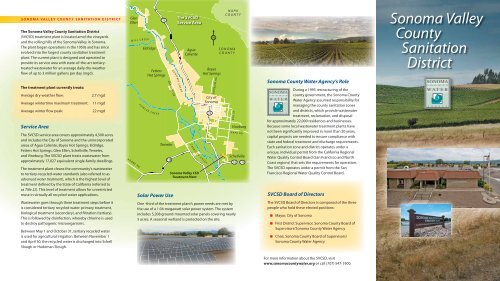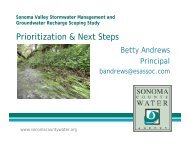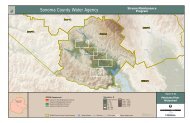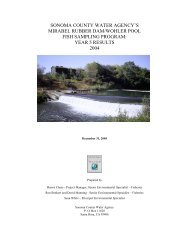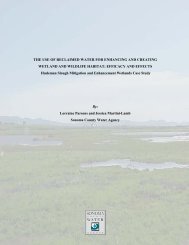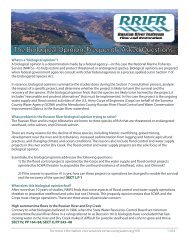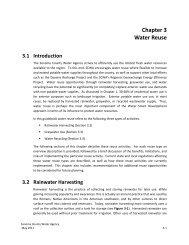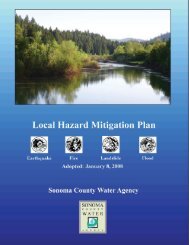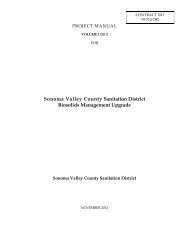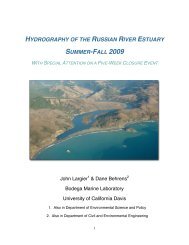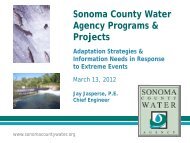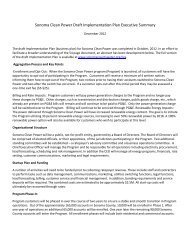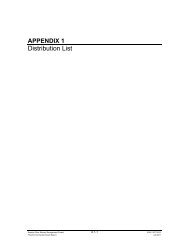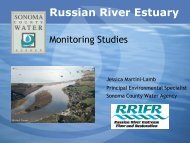Sonoma Valley County Sanitation District - Sonoma County Water ...
Sonoma Valley County Sanitation District - Sonoma County Water ...
Sonoma Valley County Sanitation District - Sonoma County Water ...
Create successful ePaper yourself
Turn your PDF publications into a flip-book with our unique Google optimized e-Paper software.
SONOMA VALLEY COUNTY SANITATION DISTRICT<br />
The <strong>Sonoma</strong> <strong>Valley</strong> <strong>County</strong> <strong>Sanitation</strong> <strong>District</strong><br />
(SVCSD) treatment plant is located amid the vineyards<br />
and the rolling hills of the <strong>Sonoma</strong> <strong>Valley</strong> in <strong>Sonoma</strong>.<br />
The plant began operations in the 1950s and has since<br />
evolved into the largest county sanitation treatment<br />
plant. The current plant is designed and operated to<br />
provide its service area with state-of-the-art tertiarytreated<br />
wastewater for an average daily dry-weather<br />
flow of up to 3 million gallons per day (mgd).<br />
The treatment plant currently treats:<br />
Average dry-weather flow:<br />
Average wintertime maximum treatment:<br />
Average winter flow peak:<br />
Service Area<br />
2.7 mgd<br />
11 mgd<br />
22 mgd<br />
The SVCSD service area covers approximately 4,500 acres<br />
and includes the City of <strong>Sonoma</strong> and the unincorporated<br />
areas of Agua Caliente, Boyes Hot Springs, Eldridge,<br />
Fetters Hot Springs, Glen Ellen, Schellville, Temelec,<br />
and Vineburg. The SVCSD plant treats wastewater from<br />
approximately 17,027 equivalent single-family dwellings.<br />
The treatment plant cleans the community’s wastewater<br />
to tertiary-recycled-water standards (also referred to as<br />
advanced water treatment), which is the highest level of<br />
treatment defined by the State of California (referred to<br />
as Title 22). This level of treatment allows for unrestricted<br />
reuse in virtually all recycled-water applications.<br />
Glen<br />
Ellen<br />
M I L L C R E E K<br />
ADOBE RD<br />
F O W<br />
Eldridge<br />
L E R<br />
Fetters<br />
Hot Springs<br />
C R<br />
E E K<br />
12<br />
ARNOLD DR<br />
Temelec<br />
116<br />
Solar Power Use<br />
S O N O M A C R<br />
The SVCSD<br />
Service Area<br />
E E K<br />
Agua<br />
Caliente<br />
C A R R<br />
I G<br />
<strong>Sonoma</strong> <strong>Valley</strong> CSD<br />
Treatment Plant<br />
E R C R E<br />
N<br />
Boyes<br />
Hot Springs<br />
City of<br />
<strong>Sonoma</strong><br />
E K<br />
12<br />
NORBOM RD<br />
NAPA<br />
COUNTY<br />
SONOMA<br />
COUNTY<br />
8TH ST<br />
Vineburg<br />
NAPA RD<br />
Schellville<br />
12<br />
112<br />
<strong>Sonoma</strong> <strong>County</strong> <strong>Water</strong> Agency’s Role<br />
During a 1995 restructuring of the<br />
county government, the <strong>Sonoma</strong> <strong>County</strong><br />
<strong>Water</strong> Agency assumed responsibility for<br />
managing the county sanitation zones<br />
and districts, which provide wastewater<br />
treatment, reclamation, and disposal<br />
for approximately 22,000 residences and businesses.<br />
Because some local wastewater treatment plants have<br />
not been significantly improved in more than 20 years,<br />
capital projects are needed to ensure compliance with<br />
state and federal treatment and discharge requirements.<br />
Each sanitation zone and district operates under a<br />
unique, individual permit from the California Regional<br />
<strong>Water</strong> Quality Control Board (San Francisco and North<br />
Coast regions) that sets the requirements for operation.<br />
The SVCSD operates under a permit from the San<br />
Francisco Regional <strong>Water</strong> Quality Control Board.<br />
SVCSD Board of Directors<br />
<strong>Sonoma</strong> <strong>Valley</strong><br />
<strong>County</strong><br />
<strong>Sanitation</strong><br />
<strong>District</strong><br />
Wastewater goes through three treatment steps before it<br />
is considered tertiary recycled water: primary treatment,<br />
biological treatment (secondary), and filtration (tertiary).<br />
This is followed by disinfection, whereby chlorine is used<br />
to destroy pathogenic microorganisms.<br />
Between May 1 and October 31, tertiary recycled water<br />
is used for agricultural irrigation. Between November 1<br />
and April 30, the recycled water is discharged into Schell<br />
Slough or Hudeman Slough.<br />
One -third of the treatment plant’s power needs are met by<br />
the use of a 1.04-megawatt solar power system. The system<br />
includes 5,208 ground-mounted solar panels covering nearly<br />
5 acres. A seasonal wetland is protected on the site.<br />
The SVCSD Board of Directors is composed of the three<br />
people who hold these elected positions:<br />
◾ Mayor, City of <strong>Sonoma</strong><br />
◾ First <strong>District</strong> Supervisor, <strong>Sonoma</strong> <strong>County</strong> Board of<br />
Supervisors/<strong>Sonoma</strong> <strong>County</strong> <strong>Water</strong> Agency<br />
◾ Chair, <strong>Sonoma</strong> <strong>County</strong> Board of Supervisors/<br />
<strong>Sonoma</strong> <strong>County</strong> <strong>Water</strong> Agency<br />
For more information about the SVCSD, visit<br />
www.sonomacountywater.org or call (707) 547-1900.
SONOMA VALLEY COUNTY SANITATION DISTRICT<br />
1<br />
Headworks Raw sewage from domestic and commercial sources enters<br />
the treatment plant at the headworks. At this point large inorganic solids<br />
in the waste stream are removed. Smaller solids, or grit, are removed<br />
from the wastewater before it enters the aeration basins.<br />
Treatment Facilities<br />
and Processes<br />
4<br />
5<br />
8<br />
Operations Building The operations<br />
building contains personnel offices, facilities<br />
to control plant functions, and a laboratory<br />
to evaluate plant performance.<br />
7<br />
Storage Reservoirs Three<br />
off-site reservoirs with a<br />
combined capacity of nearly<br />
200 million gallons are used<br />
to store recycled water<br />
from the tertiary filters. The<br />
recycled water stored in the<br />
reservoirs is used to irrigate<br />
more than 2,000 acres of premium grapes in the Carneros appellation. Recycled water is also used<br />
for irrigation of dairy fodder crops. Tertiary water that does not meet water-quality standards is<br />
automatically diverted to the 1.5-million-gallon equalization basin, where it is then pumped back<br />
to the headworks or to an aeration basin for retreatment.<br />
3<br />
3<br />
EQUALIZATION<br />
BASIN<br />
S O L A R<br />
P A N E L S<br />
6<br />
2<br />
Aeration Basins The wastewater undergoes biological treatment in<br />
the aeration basins. Air is injected into the wastewater to promote the<br />
growth of microorganisms that feed on organic materials in the sewage.<br />
6<br />
1<br />
8<br />
2<br />
2<br />
2<br />
2<br />
E Q U A L I Z A T I O N B A S I N<br />
Solids Handling The<br />
excess sludge in the<br />
wastewater system is<br />
removed from the<br />
treatment process and<br />
compacted in a press<br />
for disposal in a landfill.<br />
E Q U A L I Z A T I O N B A S I N<br />
3<br />
Secondary Clarifiers Wastewater undergoing biological treatment in the<br />
aeration basins is pumped to the clarifiers to separate the water from the solids.<br />
The suspended heavier materials settle to the bottom of the clarifiers as a thin<br />
mud—called sludge—and are returned to the aeration basins. Secondary-treated<br />
water flows over the weirs of the clarifier and is sent to the tertiary filters.<br />
4<br />
Tertiary Treatment Filters The clear effluent<br />
(treated wastewater) from the secondary<br />
clarifiers is filtered through an approved tertiary<br />
filter to produce recycled water. This filtering<br />
process removes the remaining suspended<br />
solids in the effluent. To prevent clogging, the<br />
solids that accumulate in the filters must be<br />
occasionally flushed out during a backwash<br />
cycle and returned to the aeration basins.<br />
5<br />
Disinfection The clear effluent from the tertiary filters<br />
flows into the chlorine contact chamber, where pathogenic<br />
microorganisms are destroyed. After disinfection, any<br />
remaining chlorine is neutralized with sulfur dioxide.


